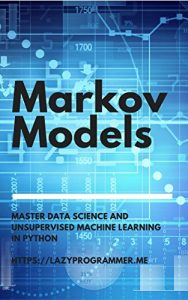Markov Models are all about learning sequences.
A lot of the data that would be very useful for us to model is in sequences. Stock prices are sequences of prices. Language is a sequence of words. Credit scoring involves sequences of borrowing and repaying money, and we can use those sequences to predict whether or not you’re going to default. In short, sequences are everywhere.
The easiest way to appreciate the kind of information you get from a sequence is to consider what you are reading right now. If I had printed the previous sentence backwards, it wouldn’t make much sense to you, even though it contained all the same words. So order is important.
While the current fad in deep learning is to use recurrent neural networks (LSTM) to model sequences, I want to first introduce you guys to a machine learning algorithm that has been around for several decades now - the Markov Model.
This book follows directly from my first course in Unsupervised Machine Learning for Cluster Analysis, where you learned how to measure the probability distribution of a random variable. In this course, you’ll learn to measure the probability distribution of a sequence of random variables.
This course is also going to go through the many practical applications of Markov models. We’re going to look at a model of sickness and health, and calculate how to predict how long you’ll stay sick, if you get sick. We’re going to talk about how Markov models can be used to analyze how people interact with your website, and fix problem areas like high bounce rate, which could be affecting your SEO. We’ll build language models that can be used to identify a writer and even generate text - imagine a machine doing your writing for you.
We’ll look at what is possibly the most recent and prolific application of Markov models - Google’s PageRank algorithm. It is surprising that the world's leading search engine could have made its money on what is essentially an undergraduate linear algebra problem.
If you think Markov models aren't relevant to your life, think again. Even smartphone autosuggestions can be programmed using Markov models.
Amazingly, all the technologies we discuss in this book can be downloaded and installed for FREE. That means all you need to invest after purchasing this book is your effort and your time. The only prerequisites are that you are comfortable with Python and the Numpy stack and you know the basics of probability.
A lot of the data that would be very useful for us to model is in sequences. Stock prices are sequences of prices. Language is a sequence of words. Credit scoring involves sequences of borrowing and repaying money, and we can use those sequences to predict whether or not you’re going to default. In short, sequences are everywhere.
The easiest way to appreciate the kind of information you get from a sequence is to consider what you are reading right now. If I had printed the previous sentence backwards, it wouldn’t make much sense to you, even though it contained all the same words. So order is important.
While the current fad in deep learning is to use recurrent neural networks (LSTM) to model sequences, I want to first introduce you guys to a machine learning algorithm that has been around for several decades now - the Markov Model.
This book follows directly from my first course in Unsupervised Machine Learning for Cluster Analysis, where you learned how to measure the probability distribution of a random variable. In this course, you’ll learn to measure the probability distribution of a sequence of random variables.
This course is also going to go through the many practical applications of Markov models. We’re going to look at a model of sickness and health, and calculate how to predict how long you’ll stay sick, if you get sick. We’re going to talk about how Markov models can be used to analyze how people interact with your website, and fix problem areas like high bounce rate, which could be affecting your SEO. We’ll build language models that can be used to identify a writer and even generate text - imagine a machine doing your writing for you.
We’ll look at what is possibly the most recent and prolific application of Markov models - Google’s PageRank algorithm. It is surprising that the world's leading search engine could have made its money on what is essentially an undergraduate linear algebra problem.
If you think Markov models aren't relevant to your life, think again. Even smartphone autosuggestions can be programmed using Markov models.
Amazingly, all the technologies we discuss in this book can be downloaded and installed for FREE. That means all you need to invest after purchasing this book is your effort and your time. The only prerequisites are that you are comfortable with Python and the Numpy stack and you know the basics of probability.






